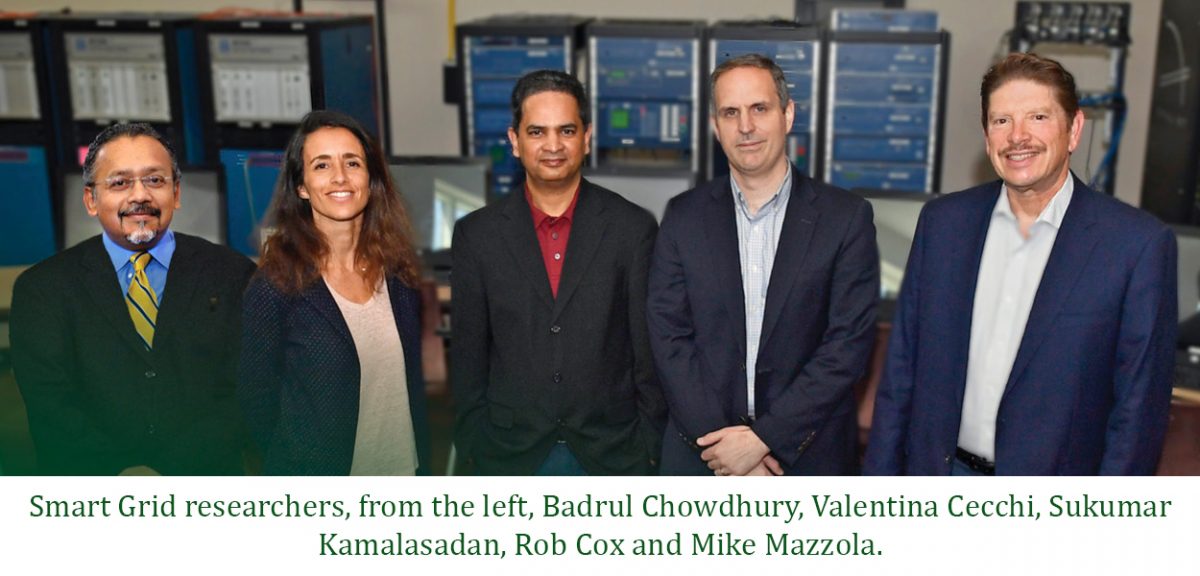FACULTY AND STAFF RECOGNIZED FOR RESEARCH ACCOMPLISHMENTS, ILLUMINATING UNC CHARLOTTE’S ‘STAR ON THE RISE’
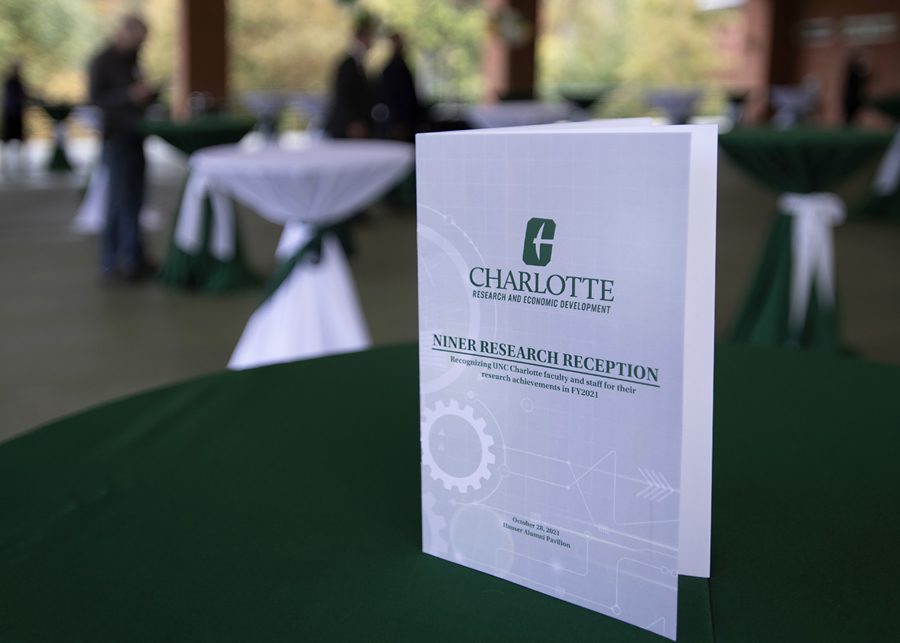
By: Susan MessinaTuesday, November 2, 2021
On Oct. 28, UNC Charlotte recognized members of the faculty and staff for their new and ongoing achievements in research at the 2021 Niner Research Reception. The event, held this year at Hauser Alumni Pavilion, brought together faculty and staff from across the University and highlighted the accomplishments of 278 researchers in 15 award categories.
“Our success as a research institution is reflected in your success,” said Rick Tankersley, vice chancellor for the Research and Economic Development Office, to those gathered. “There is no question that UNC Charlotte’s star is on the rise, and our research enterprise is expanding in exciting ways.”
Tankersley noted that despite the challenges presented by the global COVID-19 pandemic, nearly 800 research proposals were submitted, translating to three per working day. These resulted in:
- 207 New Awards (recipient of at least one new award)
- 34 First Awards (first award at UNC Charlotte)
- 12 Big Awards ($1M+)
- 188 PIs (principal investigator on a new award)
- 69 Co-PIs (co-principal investigators on a new award)
- 62 Multiple Awards (recipients of two-plus awards)
- 97 Collaborative Awards (two-plus faculty or staff members from different departments/units)
- 43 Multi-college Awards participants in a sponsored award with two-plus others in different colleges)
- 56 Multi-institution Awards (participants in a sponsored award with one or more researchers from another university)
- 10 New Faculty (tenured or tenure track faculty who joined the University in fall 2020 and fall 2021)
- 16 New Patent Awards
- 5 New Startup Awards
- 12 I-Corps (completed Ventureprise’s NSF I-Corps program)
- 48 Supplement Awards (PI on a research supplement to an existing award)
- 24 faculty participated in Catalyst Boot Camps for STEM+ and Arts and Humanities
A strategic focus on research
Chancellor Sharon L. Gaber emphasized the role of research as a strategic area of focus in UNC Charlotte’s new 10-year strategic plan, “Shaping What’s Next.” She said, “For the next decade we will define our commitment to expanding UNC Charlotte’s research enterprise as ‘powering the future through inquiry, research and creative discovery.’ Your work will be critically important as we make that happen — and pursue our goal to become a top-tier research university.”
Since last December, an R1 commission, composed of key University faculty, staff and administrators, has convened to study the University’s potential path to becoming a top-tier research university. Tankersley announced the commission’s report and recommendations will be available in the coming weeks. The report will include strategies and tactics for expanding grant-seeking training and support for proposal development, strengthening and expanding existing doctoral programs, growing community engaged and use-inspired research, expanding seed grant and planning grant opportunities, adopting a cluster-hire culture, expanding efforts to attract and retain top-notch faculty and aligning doctoral training with existing areas of excellence and industry needs.
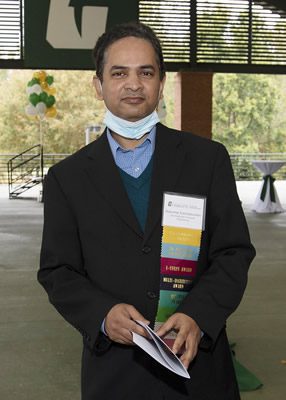 “It’s encouraging that community-engaged research is supported and understood as vital to the well-being of the city and region,” said Tamara Johnson, director of engaged scholarship, Office of Urban Research and Community Engagement, who received a New Award and a Co-PI Award as well as recognition for collaboration. Sonyia Richardson, assistant professor, School of Social Work, who earned bachelor’s and doctoral degrees from UNC Charlotte, and received New and PI awards, added, “I’m honored and inspired to attempt to pursue additional funding for future research opportunities.”
“It’s encouraging that community-engaged research is supported and understood as vital to the well-being of the city and region,” said Tamara Johnson, director of engaged scholarship, Office of Urban Research and Community Engagement, who received a New Award and a Co-PI Award as well as recognition for collaboration. Sonyia Richardson, assistant professor, School of Social Work, who earned bachelor’s and doctoral degrees from UNC Charlotte, and received New and PI awards, added, “I’m honored and inspired to attempt to pursue additional funding for future research opportunities.”
The commission’s report also will include a list of 17 areas of research focus and distinction, which will serve as an invitation to faculty to participate in UNC Charlotte’s strategic progress.
“The steps UNC Charlotte is taking are extremely important as we pursue top-tier research status,” said Sukumar Kamalasadan, Duke Distinguished Professor of Engineering, Department of Electrical and Computer Engineering, whose research interests span smart grid design and modernization, renewable energy integration and other topics. He received Collaborative, Co-PI, I-Corps, Multi-Institution, Multiple, New, PI and Supplemental Awards for 2021. “I look forward to learning more about ways the forthcoming research plan will be implemented for success.”
Photo, inset, Sukumar Kamalasadan, Department of Electrical and Computer Engineering, received eight recognitions at the 2021 Research Reception as depicted by the ribbons on his nametag.
https://inside.charlotte.edu/news-features/2021-11-02/faculty-and-staff-recogniz…
Optimal Reconfiguration and Resilient Control Framework for Real-Time Photovoltaic Dispatch to Manage Critical Infrastructure (ReDis-PV)
ABOUT ReDis-PV
The consortium is conducting cutting-edge collaborative research that will allow to advance solar energy’s role in strengthening the resilience of the U.S. electricity grid. The U.S Department of Energy Solar Technologies Office (SETO) has awarded $4.6 million to Professor Sukumar Kamalasadan (The University of North Carolina at Charlotte) for the project “Optimal Reconfiguration and Resilient Control Framework for Real-Time Photovoltaic Dispatch to Manage Critical Infrastructure (ReDis-PV)”. The project will develop a grid management tool that detects cyber and physical threats, and forms dynamic clusters to optimally manage photovoltaic and energy. The project collaborating team includes University of North Carolina at Charlotte, Clemson University, New Mexico State university, Florida International University, Argonne National Laboratory, Idaho National Laboratory, OPAL-RT Corporation and Duke Energy.
Lead Organization: The University of North Carolina at Charlotte
Principal Investigator: Dr. Sukumar Kamalasadan
More about the project can be found here:
UNC Charlotte Smart Grid Lab Getting Smarter
Created to educate the next generation of electrical power distribution engineers and to advance research into integrating renewable power into the grid, UNC Charlotte’s Duke Energy Smart Grid Laboratory has been fulfilling its mission since 2012. Partnering with utilities, universities and governmental agencies, the momentum of laboratory researchers has been increasing in the past two years with a number of new projects, including two major research grants from the U.S. Department of Energy Solar Energy Technologies Office (SETO) totaling more than $8 million.
Throughout the life of the Smart Grid Lab, Duke Energy has provided financial support and research expertise to advance the study of power distribution and forecasting. Students from UNC Charlotte’s W.S. Lee College of Engineering who were trained in the lab have now gone on to work for Duke Energy, and are part of ongoing research collaborations between the utility and the university.
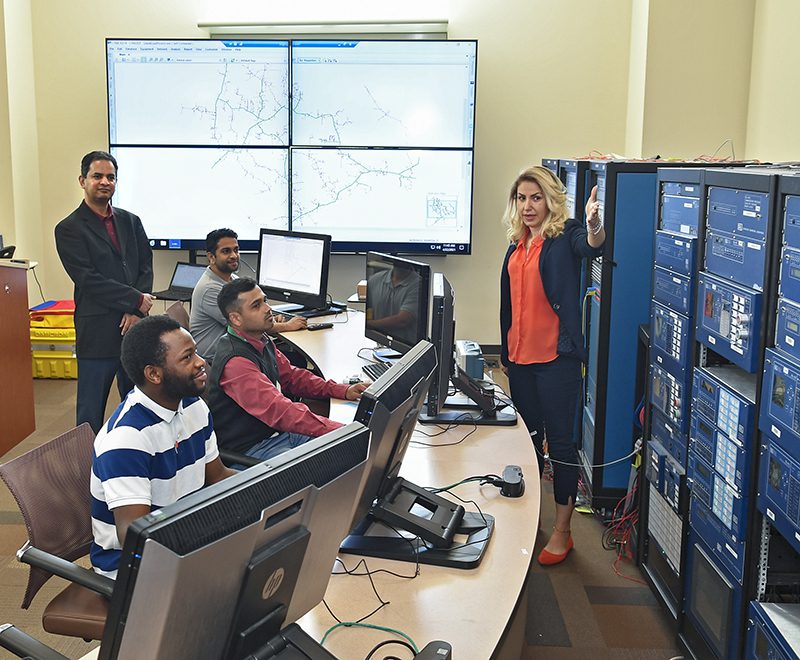 The Smart Grid Lab is part of UNC Charlotte’s Energy Production and Infrastructure Center (EPIC). “The Smart Grid Lab is a resource that allows us to build research expertise, and educate undergraduate and graduate students who are now leaders in our partnering companies,” said Dr. Mike Mazzola, Executive Director of EPIC. “Since 2018, the lab has been advancing much of its previous research to full demonstration modes, which has been the purpose of the lab from the very start. The Smart Grid Lab is at the heart of two major grants we have won in the past two years.”
The Smart Grid Lab is part of UNC Charlotte’s Energy Production and Infrastructure Center (EPIC). “The Smart Grid Lab is a resource that allows us to build research expertise, and educate undergraduate and graduate students who are now leaders in our partnering companies,” said Dr. Mike Mazzola, Executive Director of EPIC. “Since 2018, the lab has been advancing much of its previous research to full demonstration modes, which has been the purpose of the lab from the very start. The Smart Grid Lab is at the heart of two major grants we have won in the past two years.”
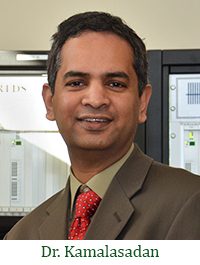 In 2020, SETO awarded $4.6 million to UNC Charlotte Electrical and Computer Engineering Professor Dr. Sukumar Kamalasadan for the project “Optimal Reconfiguration and Resilient Control Framework for Real-Time Photovoltaic Dispatch to Manage Critical Infrastructure.” The purpose of the project is to advance solar energy’s role in strengthening the resilience of the U.S. electricity grid. The project is developing a grid management tool that detects cyber and physical threats, and forms dynamic clusters to optimally manage photovoltaics and energy storage.
In 2020, SETO awarded $4.6 million to UNC Charlotte Electrical and Computer Engineering Professor Dr. Sukumar Kamalasadan for the project “Optimal Reconfiguration and Resilient Control Framework for Real-Time Photovoltaic Dispatch to Manage Critical Infrastructure.” The purpose of the project is to advance solar energy’s role in strengthening the resilience of the U.S. electricity grid. The project is developing a grid management tool that detects cyber and physical threats, and forms dynamic clusters to optimally manage photovoltaics and energy storage.
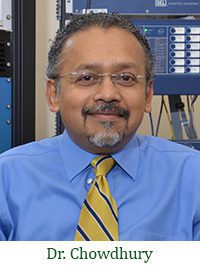 In 2021, SETO awarded a $3.6 million grant to improve the resilience and reliability of the regional electrical grid. Dr. Badrul Chowdhury, who holds a joint position as professor in the Electrical and Computer Engineering Department and the Systems Engineering and Engineering Management Department, is the principal investigator. The project, one of 10 chosen nationwide and the only one in North Carolina, is part of a collaborative effort among state government, utility companies, industry and universities to develop an advanced microgrid control architecture. The research will seamlessly coordinate microgrids with the bulk power grid at multiple points, automatically balancing load and generation while safely providing critical services. The proposed control architecture will be tested using a unique digital-twin approach, which will have direct, real-time connections between laboratories and microgrids. A field demonstration at Duke Energy’s Hot Springs microgrid is planned.
In 2021, SETO awarded a $3.6 million grant to improve the resilience and reliability of the regional electrical grid. Dr. Badrul Chowdhury, who holds a joint position as professor in the Electrical and Computer Engineering Department and the Systems Engineering and Engineering Management Department, is the principal investigator. The project, one of 10 chosen nationwide and the only one in North Carolina, is part of a collaborative effort among state government, utility companies, industry and universities to develop an advanced microgrid control architecture. The research will seamlessly coordinate microgrids with the bulk power grid at multiple points, automatically balancing load and generation while safely providing critical services. The proposed control architecture will be tested using a unique digital-twin approach, which will have direct, real-time connections between laboratories and microgrids. A field demonstration at Duke Energy’s Hot Springs microgrid is planned.
Other ongoing projects in the Smart Grid Lab include:
- Distributed Energy Storage and EV Holding Capacity with Value Proposition Development = $90,000
- Comparative Power Flow Analysis and Power Flow Quality Criteria – Phase I = $45,000
Comparative Power Flow Analysis and Power Flow Quality Criteria – Phase II = $45,000 - Identification, and Mitigation of Coordinated Attacks on Distributed Energy Management = $90,000
- Developing a Combined System Model and Simulation Process for Integrated Planning and Operations across Transmission and Distribution Systems = $200,000
- Planning an Affordable, Resilient, and Sustainable Grid in North Carolina = $201,000

Duke Energy Smart Grid Laboratory
Computers have come to the electric grid, and the Duke Energy Smart Grid laboratory at The William States Lee College of Engineering is educating the engineers who will be running this improved grid and performing research to achieve top efficiency in the new digital world.
The modernizing of the grid with digital devices is known as Smart Grid technology. This new technology is so important to improving grid efficiency that Duke Energy donated $1.8 million to help establish the Smart Grid Lab within the new Energy Production and Infrastructure Center (EPIC) building on the UNC Charlotte campus. Additional funding from the State of North Carolina for building space, equipment and infrastructure totals $1 million.
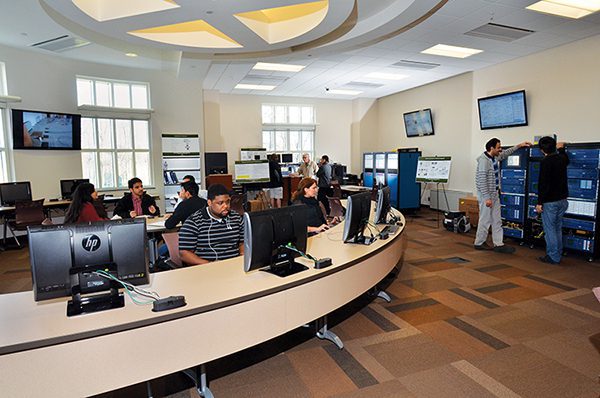 “Grid modernization is a cornerstone of the type of research we are doing in EPIC,” said Electrical and Computer Engineering Associate Professor Dr. Sukumar Kamalasadan, director of the Smart Grid Lab. “As such, we have been given a very beautiful corner location in the EPIC building to build our lab. It is a key spot in the building for demonstrating our research and educational programs.”
“Grid modernization is a cornerstone of the type of research we are doing in EPIC,” said Electrical and Computer Engineering Associate Professor Dr. Sukumar Kamalasadan, director of the Smart Grid Lab. “As such, we have been given a very beautiful corner location in the EPIC building to build our lab. It is a key spot in the building for demonstrating our research and educational programs.”
The lab is important to both undergraduate and graduate education. “We are teaching the next generation engineers to join the power industry,” Dr. Kamalasadan said. “This lab provides the learning environment to educate students to work in the smart grid world. We are also giving them the skills to be able to engineer and design the next-generation power grid.”
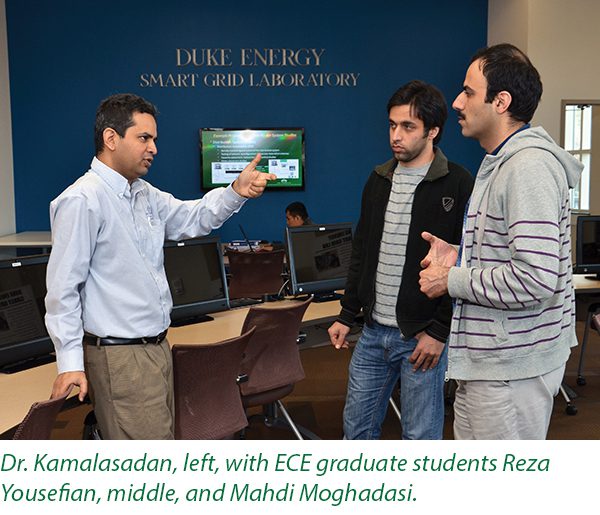 At the heart of the lab’s extensive equipment are the Real Time Digital Simulators (RTDS). “RTDS lets us work in real time,” Dr. Kamalasadan said. “We can pull in digital information about generation and transmission from multiple sources all at the same time and see how the system react during changing conditions. We can then experiment methodologies to make the power grid more efficient without putting the real grid at risk.”
At the heart of the lab’s extensive equipment are the Real Time Digital Simulators (RTDS). “RTDS lets us work in real time,” Dr. Kamalasadan said. “We can pull in digital information about generation and transmission from multiple sources all at the same time and see how the system react during changing conditions. We can then experiment methodologies to make the power grid more efficient without putting the real grid at risk.”
Advanced research and educational activities is being done in the Smart Grid lab by the EPIC Power Grid Modernization Cluster. This interdisciplinary group is composed of several faculty members and their associated graduate and undergraduate students.
Grid modernizing research deals with digitized equipment, micro-processors and micro-computers based Intelligent Electronic Devices (IED) being added to grid infrastructure to make it more reliable and efficient. Researchers collect and analyze data on how these digital systems, along with renewable energy, peaking power, redistributed loads and other components impact the grid.
“We have a huge amount of resource space that allows us to collect and analyze all of the data being sent to us by multiple utilities,” Dr. Kamalasadan said. “With RTDS we can determine how changing grid variables impact overall systems, and we can then suggest strategic grid level improvements. Most importantly, the lab will also serve as a vehicle for education and training related to grid modernization and thus help build next generation power grid workforce”
In the near future the Smart Grid Lab will be integrated with additional power systems laboratories on the ground floor of EPIC. This connection with the five labs of the Duke Energy Power Suite will allow for even greater research, education and analysis of power generation capabilities and variables.
For more information on the Smart Grid Lab contact Dr. Kamalasadan.
College of Engineering Advancing the Future of Solar Energy
At The William States Lee College of Engineering, our students, faculty and alumni are engaged in a multitude of activities that are advancing solar energy. In classrooms, our students are studying the principles of photovoltaics and tackling hands-on learning projects that teach them to work with solar energy. In laboratories, our researchers are designing improved solar cells, developing technologies for delivering solar power to the grid, and advancing methods for storing and using solar power at maximum efficiency. In the commercial world, our entrepreneurs are creating jobs as they take solar energy to the next level.
As a state university, UNC Charlotte’s mission is to deliver higher education, improve the lives of citizens and support North Carolina industry. This mission makes the Lee College of Engineering’s solar power work extremely important, because North Carolina is the second largest solar power producing state in the country.
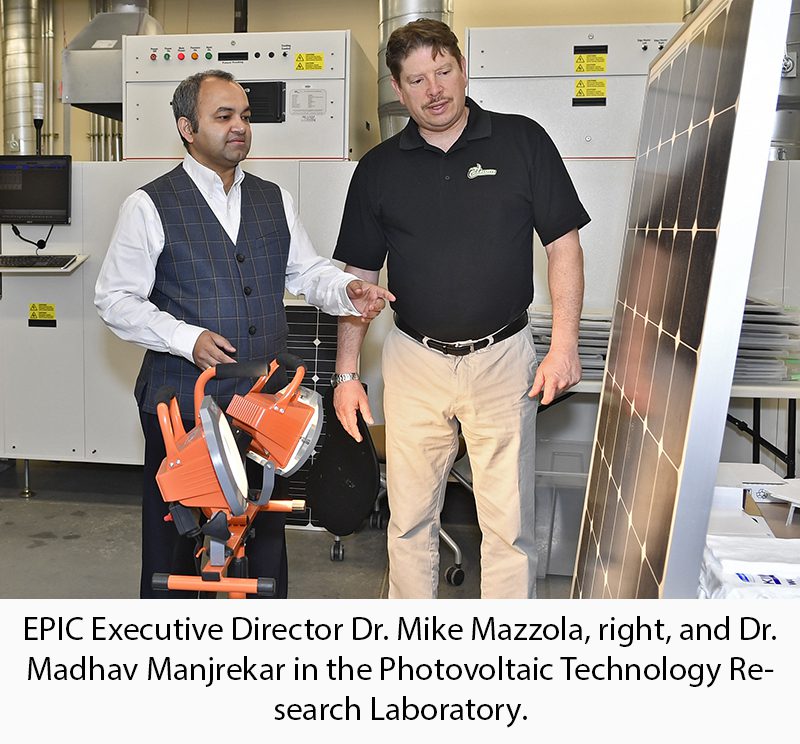 “In North Carolina we have the second most capacity to connect solar power to the grid of any state in the country, behind only California,” said Dr. Mike Mazzola, executive director of UNC Charlotte’s Energy Production and Infrastructure Center (EPIC). “And we are actually number one in utility-scale solar power, because a lot of California’s generation is from residential roof-top solar panels.”
“In North Carolina we have the second most capacity to connect solar power to the grid of any state in the country, behind only California,” said Dr. Mike Mazzola, executive director of UNC Charlotte’s Energy Production and Infrastructure Center (EPIC). “And we are actually number one in utility-scale solar power, because a lot of California’s generation is from residential roof-top solar panels.”
Solar power production in North Carolina is expected to grow even faster in the next decade, thanks in part to NC House Bill 589. The measure, a collaboration between utility officials and solar interests, establishes a competitive bidding program and a solar power leasing program.
“By allowing third-party solar producers to sell power to the grid, residential solar production will definitely be growing in North Carolina in the next few years,” Dr. Mazzola said. “South Carolina and Georgia are also adding a lot of solar capacity, making this region an even greater solar producer.”
This growing solar industry will require a larger workforce to design, build, operate and maintain it, and solar engineers will be in greater demand. To prepare these future engineers, the Lee College of Engineering has numerous solar-related educational programs at the undergraduate and graduate levels.
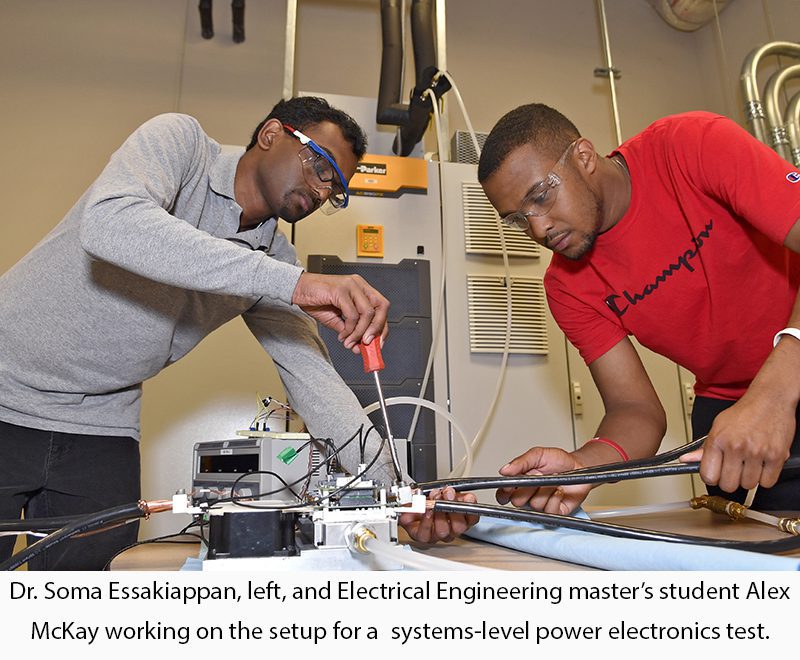 Solar Engineering Education
Solar Engineering Education
“The founding mission of EPIC is workforce development,” Dr. Mazzola said. “Through college of engineering programs, we give students a taste of renewable energy, including solar, as part of their education. These efforts help inspire students who are excited and motivated about the future of renewable energy.”
The college of engineering offers energy concentrations in all six of its undergraduate degree programs. The concentrations require students to take a group of technical electives focused on energy, which can include renewables, solar and grid integration of these technologies.
Solar energy studies may also be part of required core courses. One example is Electrical and Computer Engineering (ECE) students designing and fabricating solar cells in the Cameron Center clean room, as part of their lab work in Sophomore Design ECGR 2252.
In their year-long senior design projects, student teams have completed a number of solar-related projects in the past few years. Many of these projects are sponsored by solar power companies in the Carolinas. Examples of such senior design projects include:
- Design of a solar array micro-grid system for a 500kW solar facility in connection with SCE&G.
- Development of a simulation tool for Duke Energy to assess the benefits of battery energy storage on a power distribution system with large solar generation.
- Design of a rooftop photovoltaic array for a campus parking deck for UNC Charlotte Facilities.
- Development and field testing solar power companion inverters for Rivegy.
- A study to identify the potential uses of solar thermal energy at a regional utility plant on campus for UNC Charlotte Facilities.
- In a project for the Electrical Power Research Institute (EPRI) addressing the vegetation maintenance issues associated with large solar farms, students have developed autonomous lawn mowers that use solar recharging stations.
At the graduate level, Lee College of Engineering students also take renewable-energy-related courses, such as ECGR 4290 Science and Engineering of Photovoltaic. Many students also serve as research assistants, working with their faculty mentors on solar-related research.
“At all levels,” Dr. Mazzola said, “there is an educational environment and culture surrounding our students here that deals with the very-real issues involved in renewable energy, a major part of which is solar.”
Solar Engineering Research
In the area of research, the college of engineering impacts solar energy from the fundamentals of producing better materials for solar cells, to the incredibly complex issues of how to use and store photovoltaic generated power for the grid.
“With our state-of-the-art EPIC facilities, we are able to carry out solar research on a number of levels,” Dr. Mazzola said. “In our Photovoltaic Technology Research, Photovoltaic Integration, Renewable Power, Smart Grid, Flexible Energy and other laboratories, we have the capability to study, develop and test solar energy research. These capabilities are important to our researchers, and make us an attractive full-service applied research partner for working on grants with business and industry.”
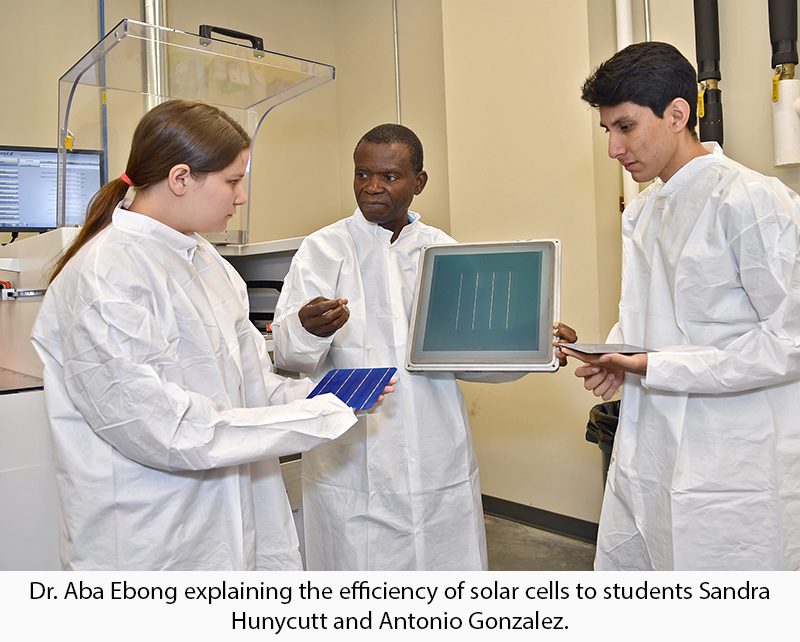 Some of the solar research now underway in EPIC laboratories includes:
Some of the solar research now underway in EPIC laboratories includes:
- In the Photovoltaic Technology Research Laboratory, led by Dr. Aba Ebong, ECE, researchers are designing, manufacturing and testing new ways to make solar cells. The research is leading to improved efficiency in solar cells, while at the same time developing manufacturing techniques to make them more cheaply. Improvement methods include increasing the number of busbars to five from the standard three, using grid line segmentation to reduce metal shading to less than five percent, and using bifacial solar structures.
- Dr. Yong Zhang’s, ECE, research involves growing new semiconductor materials for power electronics, including solar power applications. Using molecular beam epitaxy methods, he and his students build materials a layer at a time, with each layer being as thin as one atom.
- The Photovoltaic Integration Lab is developing inverters for the crucial power interface between photovoltaic solar panels and the grid. Under the direction of Dr. Babak Parkhideh, ECE, the lab is using advanced power electronics to make inverters smaller and more flexible, with better efficiencies for PV integration
- Led by Dr. Madhav Manjrekar, the Renewable Power Laboratory consists of solar array simulators from Ametek, which can mimic power profiles generated either by a single solar panel or a large solar array. Capable of supplying from 35Vdc up to 1000Vdc, these simulators can be employed to test the latest panel-level micro-inverters or central solar inverters that support dc link voltages upwards of 800Vdc.
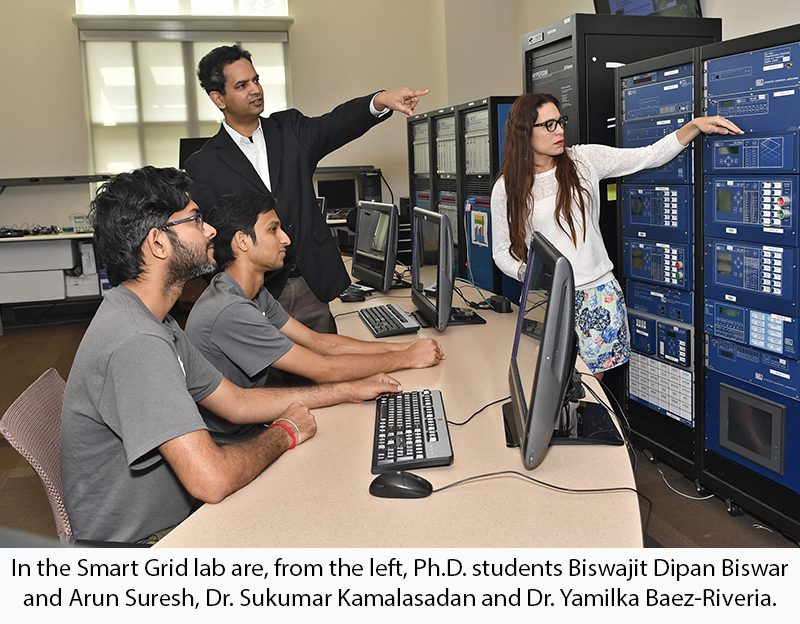 A solar power research area of growing importance is the prediction, storage and use of solar generated power. A number of UNC Charlotte faculty are working on this issue.
A solar power research area of growing importance is the prediction, storage and use of solar generated power. A number of UNC Charlotte faculty are working on this issue.
“The question is, when are people going to turn on the lights? When is the power going to be used? There has always been a degree of uncertainty knowing this,” Dr. Mazzola said. “With 10 percent of generation during the day now being solar, which has its own degrees of uncertainty, the questions of supply and demand become even more complex. And in the near future, when even more people have their own residential solar power to use and to sell to the grid, this will become even more complicated.”
Researchers working on these questions include:
- Dr. Tao Hong and his Systems Engineering students are experts in the area of energy forecasting and optimization. Their work applies various statistical and optimization techniques to the development of algorithms and tools for energy forecasting, power system planning, renewable integration, reliability planning and risk management.
- Working with a Duke Energy photovoltaic and battery storage system testbed, Dr. Sukumar Kamalasadan, ECE, and his students are compiling data and creating algorithms to increase the efficiency of how solar power is used on the grid. The work includes solutions for when to use the energy directly, when to store it in batteries, and when to use the battery power.
- Working to various degree in the areas of advanced renewable energy systems modeling and analytical systems, integration of renewable energy resources, renewable forecasting, grid market integration and building control systems, are Dr. Valentina Cecchi, ECE, Dr. Umit Cali, Engineering Technology and Construction Management (ETCM), Dr. Weimin Wan, ETCM, and Dr. Badrul Chowdhury, ECE and Systems Engineering.
Solar Engineering Entrepreneurship
Taking UNC Charlotte’s applied solar technology research to the next level, a number of startup companies have been formed to commercialize photovoltaic power solutions.
“We’ve become a leader in entrepreneurship,” Dr. Mazzola said. “Beyond working on the fundamental problems of the technology, our researchers are also heling to spin off a number of companies. This application of research directly impacts North Carolina’s future by creating jobs and strengthening our economy.”
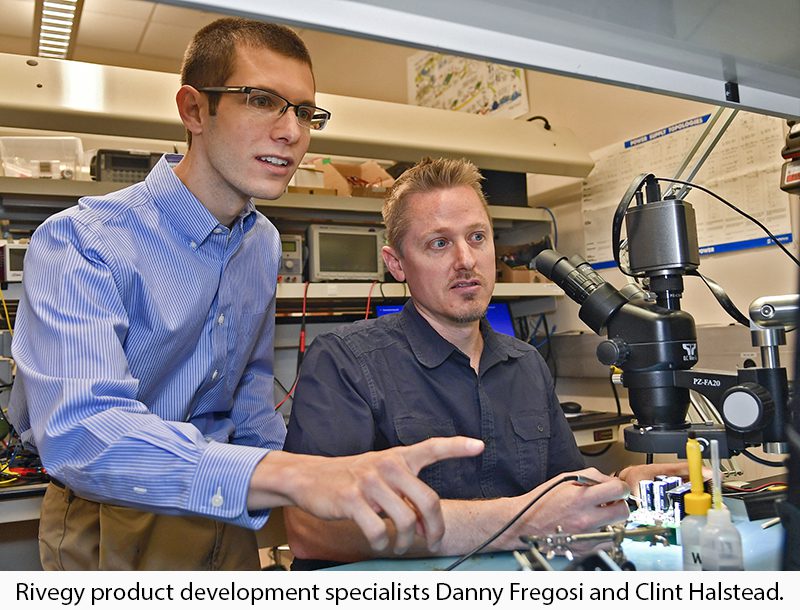 Rivegy is a National Science Foundation Small Business Innovation Research (SBIR) grant funded company that was spun off from UNC Charlotte research. Oak Ridge National Laboratory is also collaborating with the company on power electronics architecture. Rivegy is developing power electronics for use in solar and other distributed energy applications. Its proprietary Rivegy SDSI (Software-defined Synthetic Inverter) enables low-cost, long-life, high-efficiency, and flexibility to usher in the next generation of smart distributed energy systems.
Rivegy is a National Science Foundation Small Business Innovation Research (SBIR) grant funded company that was spun off from UNC Charlotte research. Oak Ridge National Laboratory is also collaborating with the company on power electronics architecture. Rivegy is developing power electronics for use in solar and other distributed energy applications. Its proprietary Rivegy SDSI (Software-defined Synthetic Inverter) enables low-cost, long-life, high-efficiency, and flexibility to usher in the next generation of smart distributed energy systems.
Founded in 2011, the startup company Sinewatts works closely with researchers in the EPIC Photovoltaic Integration Lab. The company has won two rounds of funding from the Department of Energy’s SunShot Program. Its products are microchip inverters that convert the energy coming from solar panels from direct current (DC) to alternating current (AC).
Solar Engineering Future
For the future, advance solar technologies will continue to be developed and refined. As legislation makes solar a more viable technology for home owners, the complexity of managing solar power will become even greater.
“Solar power engineers will be needed in all these new areas to solve future problems,” Dr. Mazzola said. “We are educating and preparing these engineers. We are continuing to integrate more solar, and other renewable energy studies, into our curricula.”
The social sciences, and even political science, will also play a bigger role in the future management of solar power, as consumer mindsets about energy use begin to change.
“Right now, the amount of power we generate follows the amount of energy load that is needed,” Dr. Mazzola said. “We’re starting to see indications that there could be a complete reversal of this in the future, which means load demand will follow generation capability instead of visa versa. It’s going to be an interesting time. The research in our laboratories and the technologies developed by our spinoff companies is going to be extremely important in the creation of and management of solar power. At UNC Charlotte, we’re looking forward to it. We’re here and we’re ready.”
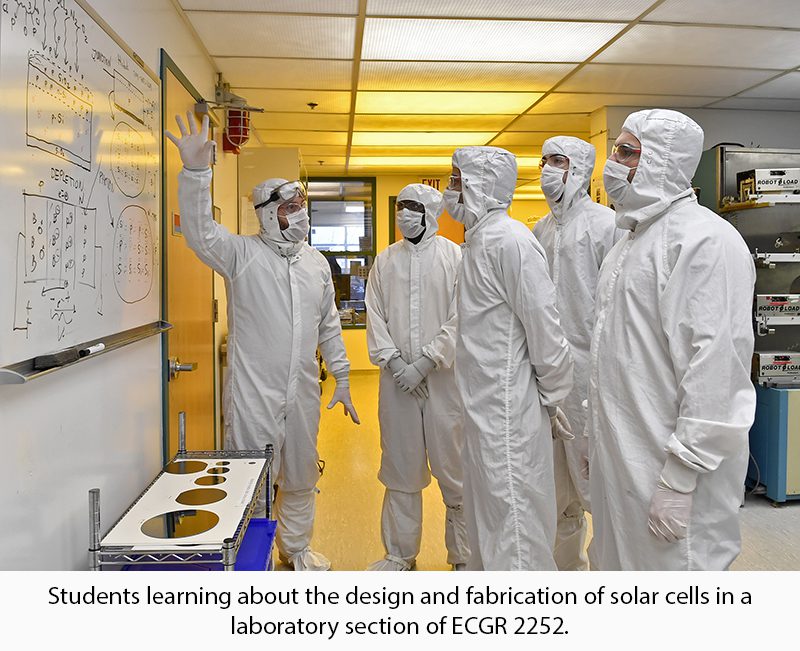
Battery Energy Storage System Management for Improving Power Grid Reliability
To improve the way solar power is integrated and distributed to the grid using grid level batteries, Electrical and Computer Engineering Associate Professor Dr. Sukumar Kamalasadan and his students have been performing research at Duke Energy’s photovoltaic and battery storage system testbed in Catawba County since 2013. The research has developed and quantified a number of cost-saving measures, and soon the value-management system will be integrated in the field for managing the solar power farm.
The Power Grid Connected Energy Storage Management project initially began as a battery storage system study for use with photovoltaics as part of grid modernization. The purpose was to solve the inconsistency problems of photovoltaics caused by weather changes. The researchers worked to balance solar power capacity by using batteries that are charged at times of excess solar output and then discharged when the power is needed on the grid.
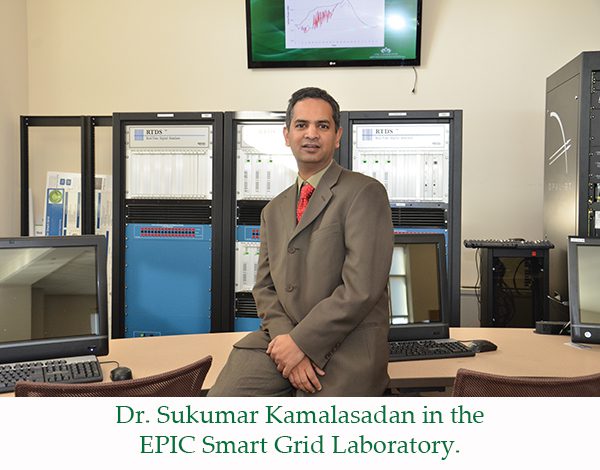 “We decided to start at the Sherrills Ford distribution feeder, which has an existing PV farm with 1 MW installed capacity,” Dr. Kamalasadan said. “Nearby is a 250 KW/750Kwh battery storage facility. Our EPIC (Energy Production and Infrastructure Center) researchers had expertise in renewables, and we formed a team to develop an algorithm to smooth the output from solar energy. We concentrated on keeping voltage levels consistent when the PV output changes due to weather and simultaneously used the battery power to feed the feeder load during peak-load times.”
“We decided to start at the Sherrills Ford distribution feeder, which has an existing PV farm with 1 MW installed capacity,” Dr. Kamalasadan said. “Nearby is a 250 KW/750Kwh battery storage facility. Our EPIC (Energy Production and Infrastructure Center) researchers had expertise in renewables, and we formed a team to develop an algorithm to smooth the output from solar energy. We concentrated on keeping voltage levels consistent when the PV output changes due to weather and simultaneously used the battery power to feed the feeder load during peak-load times.”
The first step in the research was to gather field data to be used in building the feeder model and control algorithm. Based on the data, the team developed a control strategy for more evenly distributing the photovoltaic output.
“First, in 2013-14, we developed a system to transfer the data through the internet to the Smart Grid lab at UNC Charlotte. After the communication link was successfully established we designed the initial testbed and evaluated the proof-of-concept,” Dr. Kamalasadan said. “We then deployed the algorithm on a hardware controller to connect to the battery in the field. The results showed a much more efficient control performance than sending a signal from the UNCC campus.”
Then the team developed a stacked algorithm to optimize battery charge and simultaneously supply battery power with three goals in mind, to smooth the PV farm output, regulate the voltage, and feed the feeder load at the peak power usage time. In 2015, they integrated historical weather patterns into the algorithm to optimize the amount of charge the batteries had at the start of the day, so that they would have the power needed for distribution on cloudy days or the capacity needed for storage on sunny days.
“This was very challenging,” Dr. Kamalasadan said. “There are always more variables to control in real life than what you plan for in the lab.”
In 2016, the team looked at the actual dollar value of using battery storage with the stacked algorithm to smooth PV output, and at regulating the voltage and sending power from the battery during peak load. Five main power quality and energy management areas for monetary savings were identified and savings were calculated. The team also looked at how well the controllers performed in maintaining the voltage interacting with other controllers in the field.
The next step in the project will be to develop a fully integrated value management system for use in the distribution system that will both manage the photovoltaics and calculate the overall commercial value.
“Overall Duke Energy has benefitted in optimizing the efficiency of the feeder when the PV farms are integrated,” Dr. Kamalasadan said, “and UNC Charlotte has benefitted in being able to provide this wonderful learning experience to our students. What I like about this project more than anything else is that we converted the algorithm into a value-based approach that could quantify the actual savings. We demonstrated a strong business case model that shows how the algorithm can be deployed in the field based on monetary value.”
